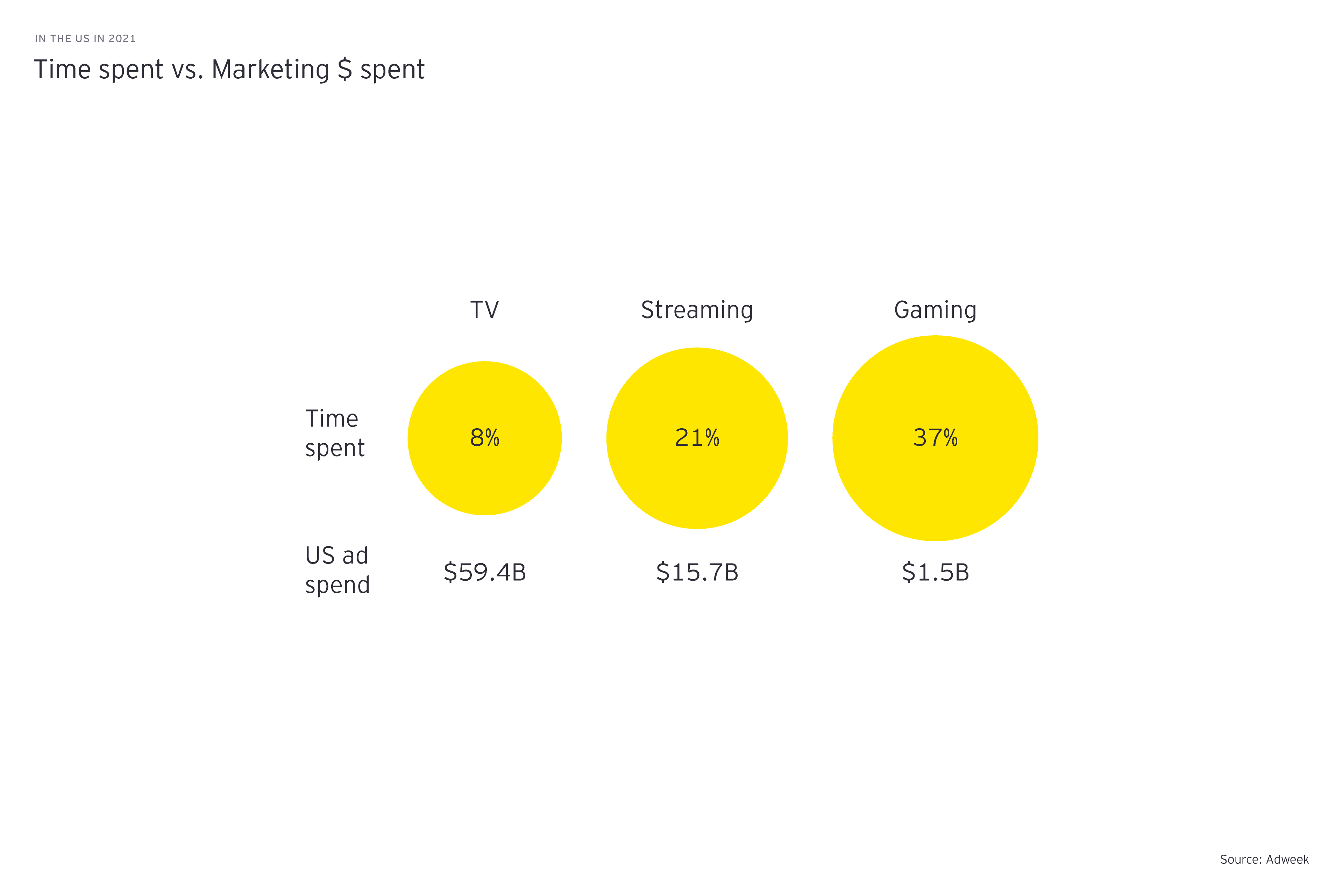EY refers to the global organization, and may refer to one or more, of the member firms of Ernst & Young Limited, each of which is a separate legal entity. Ernst & Young Limited is a Swiss company with registered seats in Switzerland providing services to clients in Switzerland.

In-game advertising continues to be an under-utilized space, despite the ongoing surge in mobile gaming.
In brief
- Brands and mobile game developers are missing out on the full potential of in-game advertising due to various misconceptions.
- Tying-in brand’s story with gameplay via relevant adverts is essential to leverage in-game advertising across the marketing journey and tap diverse audience-mix.
- The aim should be to weave ads without disrupting gaming experience and build new measurement options to attract brands.
The mobile gaming industry has been growing with stunning speed for a few years now. The COVID-19 pandemic and stay-at-home lifestyles have further propelled the growth in the industry, which witnessed a sudden surge in game downloads as never before over the past couple of years.
The overall gaming market is growing strongly and is expected to generate US$222 billion by end of 2022 with mobile gaming surpassing 60% of market share. An average person spent 4.8 hours a day on their mobile phone last year—covering one third of waking hours and up 30% from 2019. Also, gaming is not just for young mobile-savvy Gen Z anymore. Mobile has enabled gaming to go mainstream and permeate every age cohort, acting as a hotbed of prospects for players, developers, and advertisers alike. Globally expanding 5G reach and its advanced capabilities such as ultra-low latency and improved network capacity are enabling new immersive gaming experiences. The increasing number of mobile dedicated AAA titles and games with enhanced functionalities and social connection elements are attracting more audience base towards the mobile gaming. Although, post-pandemic the growth of mobile gaming market has mellowed down due to global hardware shortages, strict regulatory roadblocks in China, privacy changes from Apple, and delays to blockbuster releases; by the year end, the sector’s performance is expected to pick up.
With huge potential for growth, mobile gaming presents an increasingly immersive digital world and an enormous advertising medium that can no-longer be ignored by advertisers and developers. As a medium, in-game advertising allows game developers sell ad inventory to generate ad revenue and drive in-app purchases, at the same time improve the user experience and boost engagement by rewarding users for watching ads. It also provides brands an opportunity to reach out to a large and diverse user base which is not just restricted to millennials but now evenly cut across the gender as well as all the age groups.
With the growing popularity of in-game advertising, it is critical to shed some light around the current dynamics and important parameters to consider while sailing through this medium. This article, the first in our series of five on the mobile gaming landscape, explores why developers as well as brands should tune into in-game advertising, and how it can enable them to reach out to gaming audience in more engaging and impactful way. In next articles, we will be exploring how the leading monetization strategies can be leveraged by developers to tap multiple revenue streams. We will also be exploring how 5G, cloud gaming and mobile eSports are unlocking new growth opportunities, and how these will transform the mobile gaming experiences in future.
In-game advertising - yet to realize its full potential
Despite high penetration, time spent, reach, scale, and potential for advertising, mobile gaming as a marketing channel is still under-utilized. One of the long-lasting misconceptions that mobile gaming apps are only used by male audience and youngsters is most likely the main cause of the lag in ad spending on mobile game apps. In addition, advertisers’ reluctance to invest in mobile gaming and other major challenges for the growth of this space includes concerns regarding brand safe gaming environments, advertisements intruding the gameplay and the experience, and the measurement capabilities for in-game advertising.

In the next section, we will demystify these misconceptions as well as look at how brands as well as developers can effectively approach and implement in-game advertising.
How can in-game advertising unlock new branding opportunities?
Pick the right variants of in-game ads to fully capitalize on its potential and effectively reach the intended audience
Thanks to in-game advertising, advertisers now have more alternative and engaging ad formats, which no longer limits them to small banners at the bottom or top of the screen. In-game advertising has diversified right from interstitial, rich media, and rewarded video ads to in-stream video, playable ads, and advergaming. Video ads are dominant when it comes to in-game advertising on mobile as it is a dynamic ads format and syncs seamlessly without interrupting the playing experience. Advergaming is another notable format which is being leveraged by global brands for a while now to advertise their products.
COVID-19 pandemic triggered the use of games as social forums where players socialize, and experience live in-game events/concerts. Brands can host these in-game events, invite key opinion leaders (KOL) or influencers to advertise and reach out to broader gaming audience-mix. With varied advertising options to select from, brands can even configure the in-game ads and define what is brand safe for them thus minimizing the brand safety risks.
Plan a concerted approach to in-game advertising as mobile gaming brand experience is totally different than a TV commercial
Businesses considering in-game advertising as part of their media strategy, need to be extremely aware of the setting where they want to place the ads. It entails selecting non-disruptive ads formats, ideal game titles fit for the brand, and the target market. Moreover, in-game advertising is significantly distinct from traditional advertising. All of it is interactive, live, and high-attention inventory, so the rules for traditional media strategy do not usually apply to in-game advertising and brands must creatively communicate the brand story through gaming. Businesses also need to understand why people engage with gaming content and how they play games. This knowledge can aid businesses to collaborate with developers and work towards fine-tuning their messaging which can be smoothly synced with the gaming environment.
Embrace in-game advertising as a marketing channel throughout the user journey and tap diverse audience-mix
With tech advancements and evolving in-game ads space, brands and advertisers can now embed virtual elements within the games without disrupting the gameplay experience. Moreover, the depth and breadth of the mobile gaming audience continues to broaden across age groups with an almost even gender split. Nearly 3.2 billion people are estimated to play games in 2022 and the number will further grow to 3.5 billion by 2025. Of these, 47% of gamers are female and they have taken over the mobile market, where their share reaches as much as 61%. With the availability of such advanced and varied advertisements options and huge set of diverse audience-mix, businesses can leverage in-game advertising as marketing channel and effectively reach out and get access to audiences from all age cohorts at every touch point across the user journey.

Leverage in-game user data to derive crucial customer insights
With the ongoing gaming industry’s transformation, advertisers can tap into the detailed consumer data to make informed decisions and draw closed-loop marketing strategies. In-game consumer’s usage pattern highlights parameters to focus on for advertisers as well as developers. Insights derived from the consumer data can help answers crucial questions such as which features within the game are being used more frequently, retention problems or signals, areas where new in-game revenue-generating features can boost profitability, and which game genres should be targeted if a specific kind of product category is to be advertised.
Our key recommendations for brands and advertisers looking to leverage in-game advertising
|
For Brands |
For Developers |
|---|---|
|
Be extremely aware of the setting where they want to place the ads. Identify the target audience mix, select non-disruptive ad formats, ideal game genres as well as the titles fit for communicating the brand’s story |
Keep the gaming experience intact for gamers, seamlessly blend ads into the game loop to complement the in-game economy |
|
Leverage in-game customer data to make informed decisions and draw closed-loop marketing strategies |
Offer integration of measurement SDKs within the games to help brands to track the effectiveness and ROI of in-game advertising |
|
Deploy in-game advertising as marketing channel across multiple touch points throughout the user journey to communicate and engage users effectively |
Collaborate with agencies in educating brands regarding the high-growth opportunities in-game advertising |
It’s crucial for brands, game developers and ad agencies to develop creative strategies collaboratively for seamless integration of adverts into the gameplay without disrupting the user experience, while providing adequate value exchange.
Our latest thinking
Corona boom over: profit slump in the global gaming industry
Zurich, 24 July 2023. During the pandemic period, the gaming industry benefited enormously economically, but it is now clear that the Corona boom has come to an end. Last year, the revenues of the top gaming companies worldwide only increased by just under 5%. In the previous year, growth of 12.5% had been achieved, and in the pandemic year 2020, sales had even soared by almost 28%.
Summary
There is a strong and large untapped potential for brands to advertise in the mobile gaming space. Technological advancements, changing mindset of developers as well as advertisers towards seamless and immersive integration of adverts will act as catalyst for in-game advertising shaping the future of digital advertising and interactive entertainment. Moving forward, all stakeholders in the in-game advertising ecosystem, including developers, agencies and brands, have this interesting task of figuring out how to increase awareness of gaming mechanics and culture within their business to get the ad experience right, while retaining the “player first” ethos of gaming.
Acknowledgments
We would like to thank Sandeep Gupta - EY Global Media & Entertainment Analyst, Christian Plesca - EY Senior Consultant and Shrikant Gosavi - EY Global TMT Analyst for their valuable contributions to this article.




